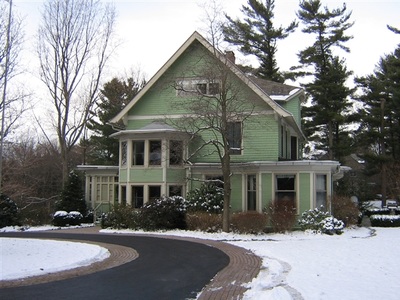Cayuga Heights, the Quintessential University Suburb

The Village of Cayuga Heights adjoining the campus of Cornell University in Ithaca, New York is the quintessential university suburb. Founded early in the twentieth century, it has enjoyed a close relationship with the university ever since.[1] Cayuga Heights of course has not been alone in enjoying such a relationship. Many residents of the City of Ithaca and all the surrounding suburbs engage in teaching, research, and public service at Cornell, which is the largest employer in Tompkins County. None of these other municipalities, however, have enjoyed as intimate a connection. A US census projection for the year 2013 showed sixty-four percent of Cayuga Heights residents out of a population of 3,729 holding graduate or professional degrees.[2] Indeed, one website offering data on urban areas claims that village residents hold more doctoral degrees than any other municipality in the entire United States.[3] This dense concentration in a small village of only 1.82 square miles in the beautiful Finger Lakes region of New York State is its distinguishing characteristic.
What follows is a short history of the Village of Cayuga Heights, begun in 2015 when the centennial of its incorporation in June 1915 was celebrated. A constant theme is the influence exerted on the village by Cornell, which coincidentally in 2015 celebrated the sesquicentennial of its founding in 1865. In other respects the story of the village is typical of twentieth century suburbanization in the United States. First developed as what was called a streetcar suburb, Cayuga Heights grew with the advent of the automobile, expanded in mid-century, and by century’s end met the qualifications of an inner ring suburb as development spread around it.[4]
What follows is a short history of the Village of Cayuga Heights, begun in 2015 when the centennial of its incorporation in June 1915 was celebrated. A constant theme is the influence exerted on the village by Cornell, which coincidentally in 2015 celebrated the sesquicentennial of its founding in 1865. In other respects the story of the village is typical of twentieth century suburbanization in the United States. First developed as what was called a streetcar suburb, Cayuga Heights grew with the advent of the automobile, expanded in mid-century, and by century’s end met the qualifications of an inner ring suburb as development spread around it.[4]
Click on the thumbnails below to read Municipal Historian Beatrice Szekely's four-part history of the Village of Cayuga Heights.
Beginnings |
On Track |
University Suburb |
Still Growing |
ENDNOTES
[1] Blake Gumprecht, “Fraternity Row, the Student Ghetto and the Faculty Enclave,” The American College Town (Amherst: University of Massachusetts Press, 2008), 71-107.
[2] US Census Bureau, “Profile of General Demographic Characteristics 2000: Educational Attainment 2009-1013, American Community Survey 5-Year Estimate, Village of Cayuga Heights,” American Fact Finder: http://factfinder.census/gov/faces/tableservices/jsf/pages/productview.xhtml?pid=ACS_13_5YR_S1501&prodType=table.
[3] City-Data.com, owned by Advaneg, Inc. in Hinsdale, Illinois: http://www.city-data.com/top2/h185.html.
[4] Kenneth T. Jackson, Crabgrass Revolution, the Suburbanization of the United States (Oxford University Press, 1985).
[1] Blake Gumprecht, “Fraternity Row, the Student Ghetto and the Faculty Enclave,” The American College Town (Amherst: University of Massachusetts Press, 2008), 71-107.
[2] US Census Bureau, “Profile of General Demographic Characteristics 2000: Educational Attainment 2009-1013, American Community Survey 5-Year Estimate, Village of Cayuga Heights,” American Fact Finder: http://factfinder.census/gov/faces/tableservices/jsf/pages/productview.xhtml?pid=ACS_13_5YR_S1501&prodType=table.
[3] City-Data.com, owned by Advaneg, Inc. in Hinsdale, Illinois: http://www.city-data.com/top2/h185.html.
[4] Kenneth T. Jackson, Crabgrass Revolution, the Suburbanization of the United States (Oxford University Press, 1985).




